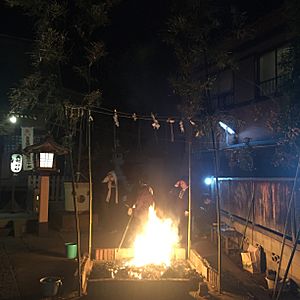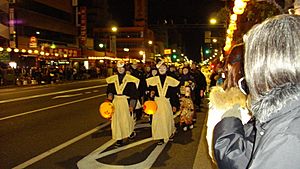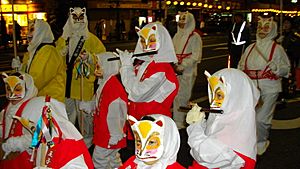Ōmisoka facts for kids
Quick facts for kids Ōmisoka |
|
|---|---|

Shinto shrine on ōmisoka
|
|
| Official name | 大晦日 |
| Also called | New Year's Eve |
| Observed by | Japan |
| Type | Cultural |
| Significance | Preparing for the new year |
| Celebrations | Kōhaku Uta Gassen |
| Date | December 31 |
| Next time | 31 December 2024 |
| Frequency | Annual |
| Related to | Japanese New Year New Year's Eve |
Ōmisoka (大晦日) is a special Japanese holiday. It happens on the last day of the year. This day is like New Year's Eve in many other countries. It is a time for people to get ready for a fresh start in the new year.
Contents
What is Ōmisoka?
The Name's Meaning
The word misoka used to mean the last day of any month. It came from the Japanese word for "30th day." The last day of the 12th month was called ōmisoka. The "ō" means "great," so it was the "great last day of the month."
Japan started using the Gregorian calendar in 1873. This is the calendar most of the world uses today. After this change, ōmisoka was set to be on December 31. This is why it is now the same as New Year's Eve.
Old Names for the Day
Another old name for this day is ōtsugomori. This word is a shorter way of saying tsukigomori. Tsukigomori means "last day of the month." These names show how important the end of the year was in old Japan.
How People Celebrate Ōmisoka
On Ōmisoka, people finish important tasks for the year. This helps them start the new year feeling fresh. Some traditions include:
- Cleaning their homes very well.
- Paying off any debts they have.
- Doing special purification rituals. These rituals help to get rid of bad luck.
- Taking a relaxing bath. This helps them feel calm for the last hours of the year.
Family Fun and TV Shows
Today, families and friends often gather together. They might have parties. A popular thing to watch is the Kōhaku Uta Gassen. This is a long singing show on TV. It lasts for over four hours! Some people also watch big mixed martial arts fights. These customs come from old Japanese beliefs. People used to show respect to the gods of the current and new years.
Special New Year's Eve Food
About an hour before midnight, many people eat a bowl of toshikoshi soba or toshikoshi udon. These are long noodles. Eating them is a tradition that means "crossing over from one year to the next." This is what toshi-koshi means. The noodles are often eaten plain. Sometimes, people add chopped scallions or tempura on top.
Families also make osechi food in the days before Ōmisoka. This special food is eaten during the first few days of the new year. It is meant to welcome the "deity of the year" into each home. It also helps people wish for happiness all year long.
Visiting Shrines and Temples
When midnight arrives, many people visit a Shinto shrine or a Buddhist temple. This first visit of the year is called Hatsumōde. Shinto shrines often give out amazake. This is a sweet, low-alcohol drink. They give it to the crowds waiting for midnight.
Most Buddhist temples have a huge bell called a bonshō. This bell is rung 108 times. Each ring is for one of the 108 earthly temptations. These temptations are believed to cause human suffering. This bell-ringing tradition is known as Joya no Kane.
New Year's Greetings
When people see someone for the last time before the new year, they say "Yoi o-toshi wo." This means "Have a good New Year." After the new year begins, the first greeting is "Akemashite omedetō." This means "congratulations on the new year."
See also
 In Spanish: Ōmisoka para niños
In Spanish: Ōmisoka para niños
- List of Buddhist festivals
- Japanese New Year
- Toshikoshi soba




